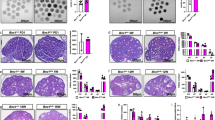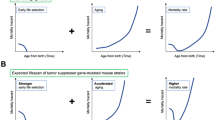Abstract
Female mammals are endowed with a finite number of oocytes at birth, each enclosed by a single layer of somatic (granulosa) cells in a primordial follicle1,2. The fate of most follicles is atretic degeneration1,3, a process that culminates in near exhaustion of the oocyte reserve at approximately the fifth decade of life in women, leading to menopause4,5. Apoptosis has a fundamental role in follicular atresia6,7, and recent studies have shown that Bax, which is expressed in both granulosa cells8,9 and oocytes10, may be central to ovarian cell death6,7,8,9,10,11,12. Here we show that young adult female Bax–/– mice possess threefold more primordial follicles in their ovarian reserve than their wild–type sisters, and this surfeit of follicles is maintained in advanced chronological age, such that 20–22–month–old female Bax–/– mice possess hundreds of follicles at all developmental stages and exhibit ovarian steroid–driven uterine hypertrophy. These observations contrast with the ovarian and uterine atrophy seen in aged wild–type female mice. Aged female Bax–/– mice fail to become pregnant when housed with young adult males; however, metaphase II oocytes can be retrieved from, and corpora lutea form in, ovaries of aged Bax–/– females following superovulation with exogenous gonadotropins, and some oocytes are competent for in vitro fertilization and early embryogenesis. Therefore, ovarian lifespan can be extended by selectively disrupting Bax function, but other aspects of normal reproductive performance remain defective in aged Bax–/– female mice.
This is a preview of subscription content, access via your institution
Access options
Subscribe to this journal
Receive 12 print issues and online access
$209.00 per year
only $17.42 per issue
Buy this article
- Purchase on Springer Link
- Instant access to full article PDF
Prices may be subject to local taxes which are calculated during checkout





Similar content being viewed by others
References
Gougeon, A. Regulation of ovarian follicular development in primates: facts and hypotheses. Endocr. Rev. 17, 121–155 (1996).
Baker, T.G. A quantitative and cytological study of germ cells in human ovaries. Proc. R. Soc. Lond. Biol. Sci. 158, 417–433 (1963).
Tilly, J.L. & Ratts, V.S. Biological and clinical importance of ovarian cell death. Contemp. Obstet. Gynecol. 41, 59–86 (1996).
Wise, P.M., Krajnak, K.M. & Kashon, M.L. Menopause: the aging of multiple pacemakers. Science 273, 67–70 (1996).
Hammond, C.B. Menopause and hormone replacement therapy: an overview. Obstet. Gynecol. 87, 2S–15S (1996).
Tilly, J.L. Apoptosis and ovarian function. Rev. Reprod. 1, 162–172 (1996).
Tilly, J.L. in When Cells Die. A Comprehensive Evaluation of Apoptosis and Programmed Cell Death (eds Lockshin, R.A., Zakeri, Z. & Tilly, J.L.) 431–452 (Wiley–Liss, New York, 1998).
Tilly, J.L., Tilly, K.I., Kenton, M.L. & Johnson, A.L. Expression of members of the bcl–2 gene family in the immature rat ovary: equine chorionic gonadotropin–mediated inhibition of granulosa cell apoptosis is associated with decreased bax and constitutive bcl–2 and bcl–x long messenger RNA levels. Endocrinology 136, 232–241 (1995).
Kugu, K. et al. Analysis of apoptosis and expression of bcl–2 gene family members in the human and baboon ovary. Cell Death Differ. 5, 67–76 (1998).
Jurisicova, A., Latham, K., Casper, R.F. & Varmuza, S.L. Expression and regulation of genes associated with cell death during murine preimplantation embryo development. Mol. Reprod. Dev. 51, 243–253 (1998).
Knudson, C.M., Tung, K.S.K., Tourtellotte, W.G., Brown, G.A.J. & Korsmeyer, S.J. Bax–deficient mice with lymphoid hyperplasia and male germ cell death. Science 270, 96–99 (1995).
Perez, G.I., Knudson, C.M., Leykin, L., Korsmeyer, S.J. & Tilly, J.L. Apoptosis–associated signaling pathways are required for chemotherapy–mediated female germ cell destruction. Nature Med. 3, 1228–1232 (1997).
Gosden, R.G., Laing, S.C., Felicio, L.S., Nelson, J.F. & Finch, C.E. Imminent oocyte exhaustion and reduced follicular recruitment mark the transition to acyclicity in aging C57BL/6J mice. Biol. Reprod. 28, 255–260 (1983).
Ratts, V.S., Flaws, J.A., Kolp, R., Sorenson, C.M. & Tilly, J.L. Ablation of bcl–2 gene expression decreases the numbers of oocytes and primordial follicles established in the post–natal female mouse gonad. Endocrinology 136, 3665–3668 (1995).
Bergeron, L. et al. Defects in regulation of apoptosis in caspase–2–deficient mice. Genes Dev. 12, 1304–1314 (1998).
Acknowledgements
We thank I. Schiff for critical reading of the manuscript before its submission. C.M.K. was supported as a Pfizer Postdoctoral Fellow and G.I.P. was supported in part by the Massachusetts General Hospital Fund for Medical Discovery and the Harvard Medical School Janet M. McArthur Fellowship. This study was supported by research grants from the National Institutes of Health to J.L.T. (R01–AG12279, R01–HD34226) and S.J.K. (R01–CA49712), and by Vincent Memorial Research Funds.
Author information
Authors and Affiliations
Corresponding author
Rights and permissions
About this article
Cite this article
Perez, G., Robles, R., Knudson, C. et al. Prolongation of ovarian lifespan into advanced chronological age by Bax-deficiency. Nat Genet 21, 200–203 (1999). https://doi.org/10.1038/5985
Received:
Accepted:
Issue Date:
DOI: https://doi.org/10.1038/5985
This article is cited by
-
miRNA sequencing analysis of healthy and atretic follicles of chickens revealed that miR-30a-5p inhibits granulosa cell death via targeting Beclin1
Journal of Animal Science and Biotechnology (2022)
-
A century of programmed cell death in the ovary: a commentary
Journal of Assisted Reproduction and Genetics (2022)
-
Effects and mechanisms of mUCMSCs on ovarian structure and function in naturally ageing C57 mice
Journal of Ovarian Research (2021)
-
Characterization of the effects of heat stress on autophagy induction in the pig oocyte
Reproductive Biology and Endocrinology (2021)
-
Structure of a mammalian sperm cation channel complex
Nature (2021)



